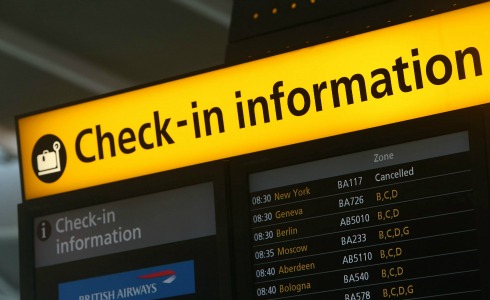
Staff and Tribune wire services
12:42 p.m. CDT, October 29, 2012
About 500 flights out of Chicago have been canceled because of the sprawling storm engulfing the East Coast.
Airlines have canceled more than 400 flights at O’Hare International Airport and more than 90 at Midway International Airport.
Most of the cancellations are due to Hurricane Sandy, which is expected to join up with two other weather systems on the East Coast to create a huge storm affecting 50 million people.
The gathering storm has also prompted the National Weather Service to issue a lakeshore flood warning for the Chicago area from 1 a.m. Tuesday until 4 p.m. Wednesday and a high wind warning from 7 a.m. to 7 p.m. Tuesday for Lake and Porter counties in northwest Indiana.
Winds as strong as 60 mph are expected to whip up waves as high as 25 feet on Lake Michigan, particularly at the south end, the weather service said.
“These large waves will batter the beaches and shorelines leading to coastal erosion and flooding,” the weather service warned, saying piers and break walls will be especially vulnerable.
Inland in northwest Indiana, the agency warned of northerly winds at 25-35 mph this afternoon with gusts up to 50 mph late this afternoon. Overnight those winds will increase to 30-40 mph with gusts up to 60 mph.
National Weather Service meteorologist Richard Castro advised waterfront high-rise residents to secure items on their balconies, and joggers and bicyclists should avoid the lake shore.
“The fact we’re seeing impact in the wind out here in the Midwest — the magnitude of this storm is really rare,” Castro said.
Sandy is so large, he added, that it’s also preventing the cool weather system over Chicago from moving out. Temperatures aren’t expected to rise higher than 50 degrees through at least Thursday.
But Chicago’s troubles are minuscule compared to those on the coast, where Hurricane Sandy is on track to collide with a wintry storm moving in from the west and cold air streaming down from the Arctic.
Government offices, schools, courthouses and transit systems shut down in the mid-Atlantic region Monday as Hurricane Sandy off the coast kicked up a threatening combination of pounding rain, wind and tidal surges.
Officials implored residents to stay off the roads while imposing evacuation orders that affected thousands of residents in low-lying coastal communities, primarily in Delaware.
In Washington, the federal and local governments closed along with the courts, public schools and the Metro system that serves about 1.2 million weekday customers. Dozens of flights in and out of two critical airports, Ronald Reagan Washington National and Dulles International, were canceled. Tourist attractions like the Smithsonian museums were off-limits, and shelters opened to feed and house hundreds.
With Sandy bringing top sustained winds of 85 mph and hurtling on a predicted path toward Washington, Baltimore, Philadelphia and New York, utilities warned power outages could affect millions and last for a week. As of Monday morning, outages in Delaware, Maryland and the District of Columbia were only sporadic.
No pocket of the region appeared safe from Sandy’s impact. Maryland Gov. Martin O’Malley said his state was “right in the crosshairs” of the storm and urged people to stay off the road for the next 36 hours.
“The days ahead are going to be very difficult,” O’Malley said. “There will be people who die and are killed in this storm.”
In mountainous western Maryland, a blizzard warning was issued for sections of Garrett County for Monday night into Tuesday morning.
O’Malley said the forecast for Maryland worsened Monday morning and he predicted Chesapeake Bay flooding would be reminiscent of the worst hurricanes in the state’s history: Gloria in 1985 and Agnes in 1972.
The stormy Atlantic Ocean covered the beach in Ocean City, where an ocean pier was significantly damaged. Tracy Lind, a front desk worker at a Holiday Inn & Suites, said the damaged pier was part of the fabric of the resort town, frequented by fishermen and visited by tourists and locals seeking a close-up look at the ocean.
“It’s kind of like an icon in Ocean City. It’s the closest people can get to the ocean without getting in,” Lind said. “I always thought that it would withstand anything.”
Mayor Rick Meehan said about 100 to 150 feet of the eastern part of the fishing pier was damaged. He also said there was significant flooding in a downtown area where officials had ordered a mandatory evacuation. About 200 people were staying in the evacuated area, police said.
While no injuries have been reported, the flooding is the worst the town has seen since Gloria, Ocean City Emergency Services Director Joe Theobald said.
“The sun will shine in Ocean City again,” Theobald said.
In Baltimore’s waterfront Fells Point neighborhood, where the city had dumped a 4-foot-tall mound of sand, Marcus Alsup was loading sandbags for neighbors Monday morning. Alsup, 54, said he doesn’t live in a waterfront area, but residents with low-lying basements were concerned about heavy rains.
“I got up this morning and figured people would need some help,” Alsup said.
In Delaware, Gov. Jack Markell ordered the evacuation of about 50,000 people in coastal communities while Wilmington, the state’s largest city, evacuated a low-lying area that is home to about 3,000 residents.
Jackson Grimes rode in a humble Wilmington Parks and Recreation shuttle bus to the American Red Cross shelter in New Castle, Del., but arrived in style, dressed in a navy blazer, striped purple bow tie and derby hat.
“You never know who you’ll meet,” Grimes said after a pizza dinner with about 30 others in the William Penn High School cafeteria.
In drenching and galloping winds, 76-year-old William Warren slowly drove around the Delaware City trailer park where has lived for nine years.
The retired general laborer said he hadn’t heard about the evacuation order that was issued Sunday for his neighborhood near the mouth of the Delaware River — but he wasn’t planning to leave.
“Where else am I going to go?” Warren said Monday morning, sitting in his car outside the mobile home where he rents a room. “It’s just going to rain, that’s all.”
On Fenwick Island, bordered on one side by the Atlantic Ocean and by Assawoman Bay on the other, Mayor Audrey Serio said she woke up with six inches of water on the ground floor of her home. Neighbors’ homes were also flooded, she said. Al Daisey stood outside his home, warily observing the bay, normally at the end of his street, creeping several feet into his yard.
“Four a.m., this road was dry,” he said.
In Lewes, Del., tree limbs were coming down and taking out power lines Monday morning. Darryl Marker said a branch took out a power line leading to his home around 9:30 a.m. In Rehoboth Beach, the main commercial streets were deserted, shops were boarded up and 12-foot waves were pounding the beach.
The Metro transit system in Washington closed for the first time since Hurricane Isabel in 2003. Officials weren’t expected to decide on restoring service until Monday evening and first needed assurances from utility companies that they would be able to maintain electricity. The system would be restored only when rail and bus travel is considered safe, spokesman Dan Stessel said.
In northern Virginia on Monday morning, roads were passable and traffic was light, reminiscent of an early Sunday morning. In the suburb of Burke, Va., residents were running errands and walking dogs amid heavy rain and little wind. On the Capital Beltway and Interstate 395 — typically choked with traffic before 9 a.m. on weekdays — motorists were slowed only by scattered accidents.
With relatively light winds in Washington Monday morning, some were having fun with the storm. A shirtless man wearing a horse’s-head mask was shown on WRC-TV cameras jogging in the flood-prone Bloomingdale neighborhood, an image that quickly went viral.
chicagobreaking@tribune.com



